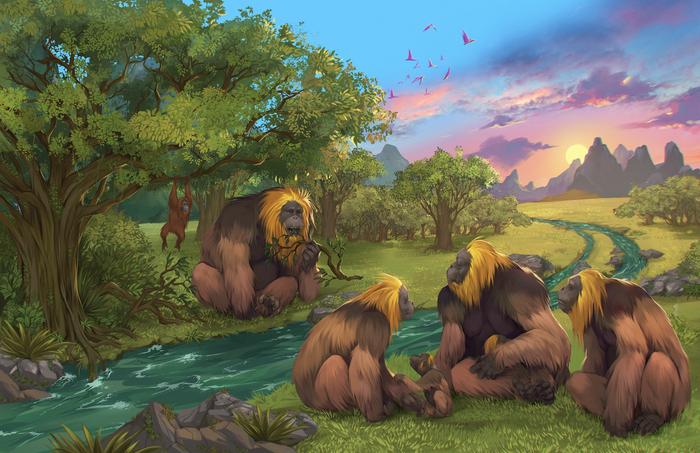The Largest Ape Stood 10 Feet Tall, But Couldn’t Rise Above Extinction
Posted on Categories Discover Magazine

If gorillas strike you as intimidating, try to imagine a nearly 10-foot lookalike: that dizzying stat belongs to none other than Gigantopithecus blacki. Don’t worry about running into this colossus of an ape when you’re out and about; G. blacki went extinct long ago, but for years, researchers couldn’t decipher exactly when and why it disappeared. The only concrete traces it has left come in the form of 2000 fossilized teeth and four jawbones.
But new evidence has finally answered these burning questions, seemingly closing the case on the enigma surrounding G. blacki’s toppling.
According to a press release, researchers from China, Australia, and the U.S. found critical pieces of the G. blacki puzzle as they explored the ape’s old stomping grounds in the Guangxi region of Southern China. The joint research team published their findings in Nature, establishing a new timeframe for G. blacki’s extinction and clarifying the conditions that prompted its downfall.
When Did G. blacki Go Extinct?
G. blacki, the team asserts, went extinct between 295,000 years and 215,000 years ago, earlier than previously assumed. They reached this conclusion based on a large-scale project gathering evidence from 22 cave sites throughout the Guangxi region. Although dating the evidence was a priority, the researchers also set out to understand the factors that led to the ape’s extinction.
“It’s a major feat to present a defined cause for the extinction of a species, but establishing the exact time when a species disappears from the fossil record gives us a target timeframe for an environmental reconstruction and behavior assessment,” said co-lead author, Macquarie University geochronologist Kira Westaway in the press release.
Read More: A Complete Dinosaur Timeline to Extinction: How Long Did They Roam Earth?
How Researchers Examined Gigantopithecus Fossils
Multiple techniques were used to date samples, notably the teeth from G. blacki. Luminescence dating, the primary technique, allowed researchers to measure light-sensitive signals in the sediments that encased the G. blacki fossils. As a result, 157 radiometric ages were produced. Combined with eight sources of environmental and behavioral evidence, these ages were applied to 11 caves that held evidence of G. blacki and 11 caves of a similar age range where no G. blacki evidence was found.
“By direct-dating the fossil remains, we confirmed their age aligns with the luminescence sequence in the sediments where they were found, giving us a comprehensive and reliable chronology for the extinction of G. blacki,” said Southern Cross University geochronologist Renaud Joannes-Boyau in the press release.
Read More: Ancient Proteins Tell Story Of Gigantopithecus, Largest-Ever Primate
Why Didn’t G. blacki Survive?
Analysis of sediments and the fossilized teeth enabled the team to model the environmental conditions that instigated the extinction of G. blacki. The teeth also provided valuable insight on the ape’s behavior when it was flourishing versus when it was becoming endangered.
The team suggests that before G. blacki went extinct, it prospered in rich and diverse forests. However, things did not bode well for the species when this environment sustained changes around 700,000 years to 600,000 years ago, around the time of a ‘warm ice age’ that altered climate cycles. During this period, the seasons grew more intense, and species were confronted with consequences that required adaptation to survive.
Orangutans, a close relative of G. blacki, found a way to surmount this challenge, adapting their size, behavior and habit preferences.
As a specialist species with a preference for specific conditions, G. blacki would not follow suit. Unlike orangutans, it turned to a less nutritious back up food source when its preferences were not available. Its downfall was also hastened as it became less mobile, and its foraging range shrunk.
Though G. blacki’s story may not have had the happiest ending, it sets a prime example of how certain species handle impending extinction.
“With the threat of a sixth mass extinction event looming over us, there is an urgent need to understand why species go extinct,” Westaway said in the press release. “Exploring the reasons for past unresolved extinctions gives us a good starting point to understand primate resilience and the fate of other large animals, in the past and future.”
Read More: 5 Massive Dinosaur Fossils and Where They Were Found